6 Specifications
6.1 Absolute Maximum Ratings
over operating free-air temperature range (unless otherwise noted)(1)
|
MIN |
MAX |
UNIT |
| VIN, VOUT |
–0.3 |
6 |
V |
| EN, OUTDIS, PFM |
–0.3 |
VIN + 0.3 with 6 V Max |
V |
| Continuous power dissipation |
Internally Limited |
°C |
| Junction temperature (TJ-MAX) |
|
125 |
°C |
| Storage temperature, Tstg |
–65 |
150 |
°C |
(1) Stresses beyond those listed under Absolute Maximum Ratings may cause permanent damage to the device. These are stress ratings only, which do not imply functional operation of the device at these or any other conditions beyond those indicated under Recommended Operating Conditions. Exposure to absolute-maximum-rated conditions for extended periods may affect device reliability.
6.2 ESD Ratings
|
VALUE |
UNIT |
| V(ESD) |
Electrostatic discharge |
Human-body model (HBM), per ANSI/ESDA/JEDEC JS-001(1) |
±1000 |
V |
| Charged-device model (CDM), per JEDEC specification JESD22-C101(2) |
±250 |
(1) JEDEC document JEP155 states that 500-V HBM allows safe manufacturing with a standard ESD control process.
(2) JEDEC document JEP157 states that 250-V CDM allows safe manufacturing with a standard ESD control process.
6.3 Recommended Operating Conditions
over operating free-air temperature range (unless otherwise noted)
|
MIN |
NOM |
MAX |
UNIT |
| VIN |
2.7 |
|
5.5 |
V |
| Junction temperature (TJ ) |
–40 |
|
125 |
°C |
| Ambient temperature (TA ) |
–40 |
|
85 |
°C |
6.4 Thermal Information
| THERMAL METRIC(1) |
LM2775 |
UNIT |
| DSG (WSON) |
| 8 PINS |
| RθJA |
Junction-to-ambient thermal resistance |
71.6 |
°C/W |
| RθJC(top) |
Junction-to-case (top) thermal resistance |
95.0 |
| RθJB |
Junction-to-board thermal resistance |
41.5 |
| ψJT |
Junction-to-top characterization parameter |
3.2 |
| ψJB |
Junction-to-board characterization parameter |
41.8 |
| RθJC(bot) |
Junction-to-case (bottom) thermal resistance |
12.8 |
(1) For more information about traditional and new thermal metrics, see the
IC Package Thermal Metrics application report,
SPRA953.
6.5 Electrical Characteristics
Typical limits tested at TA = 25°C. Minimum and maximum limits apply over the full operating ambient temperature range (−40°C ≤ TA ≤ 85°C). VIN = 3.6 V, CIN = COUT = 2.2 µF, C1 = 1 µF
| PARAMETER |
TEST CONDITIONS |
MIN |
TYP |
MAX |
UNIT |
| VOUT |
Output voltage regulation |
IOUT = 180 mA |
4.8 |
5 |
5.2 |
V |
| IQ |
Quiescent current |
IOUT = 0 mA, PFM = ‘1’ |
|
75 |
150 |
µA |
| IOUT = 0 mA, PFM = ‘0’ |
|
5 |
|
mA |
| ISD |
Shutdown current |
EN = '0' |
|
0.7 |
3 |
µA |
| IOUTDIS |
Output discharge current |
OUTDIS = '1' |
|
500 |
|
µA |
| ICL |
Input current limit |
|
|
600 |
|
mA |
| VIL |
Input logic low: EN, OUTDIS, PFM |
|
0 |
|
0.4 |
V |
| VIH |
Input logic high: EN, OUTDIS, PFM |
|
1.2 |
|
VIN |
V |
| UVLO |
Undervoltage lockout |
VIN falling |
|
2.4 |
|
V |
| VIN rising |
|
2.6 |
|
6.6 Switching Characteristics
over operating free-air temperature range (unless otherwise noted)
| PARAMETER |
TEST CONDITIONS |
MIN |
TYP |
MAX |
UNIT |
| ƒSW |
Switching frequency |
|
1.7 |
2 |
2.3 |
MHz |
6.7 Typical Characteristics
TA = 25°C, VIN = 3.6 V, CIN = COUT = 10 µF (10-V 0402 case), C1 = 1 µF (10-V 0402 case), VEN = VIN.
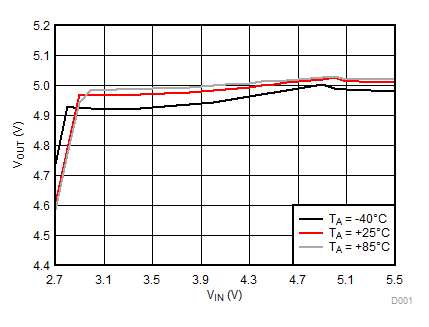 Figure 1. PWM Output Regulation
Figure 1. PWM Output Regulation
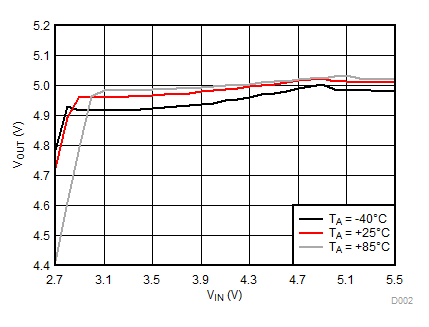 Figure 2. PFM Output Regulation
Figure 2. PFM Output Regulation
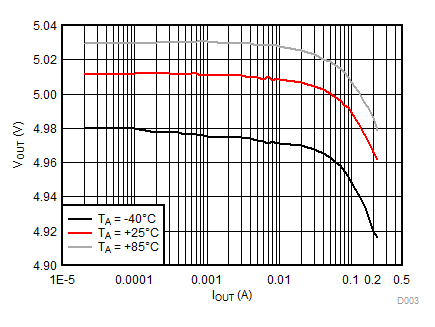 Figure 3. Load Regulation
Figure 3. Load Regulation
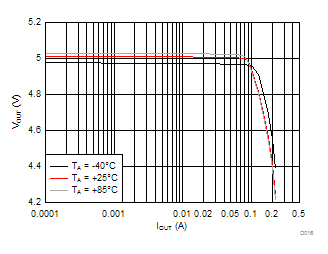 Figure 5. Load Regulation
Figure 5. Load Regulation
 Figure 7. Output Leakage Current
Figure 7. Output Leakage Current
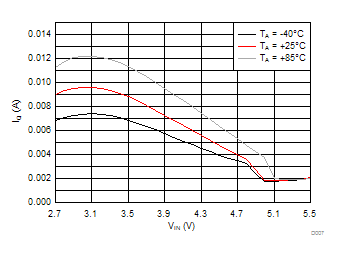 Figure 9. PWM Quiescent Current
Figure 9. PWM Quiescent Current
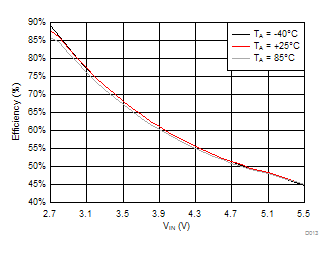 Figure 11. Efficiency vs Input Voltage
Figure 11. Efficiency vs Input Voltage
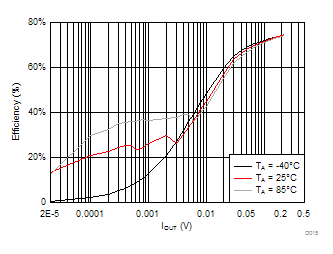 Figure 13. Efficiency vs Load Current
Figure 13. Efficiency vs Load Current
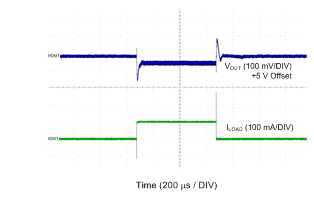
| VIN = 3.6 V |
ILOAD = 1 mA to 100 mA |
PFM = '0' |
|
|
|
Figure 15. PWM Load Step
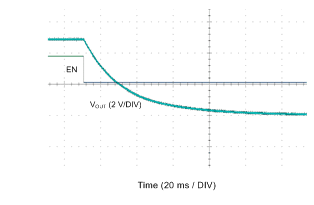 Figure 17. Output Discharge Enabled
Figure 17. Output Discharge Enabled
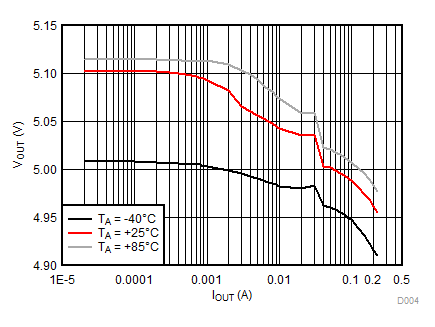 Figure 4. Load Regulation
Figure 4. Load Regulation
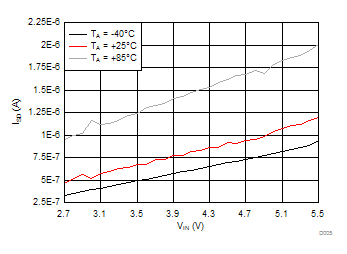 Figure 6. Shutdown Current
Figure 6. Shutdown Current
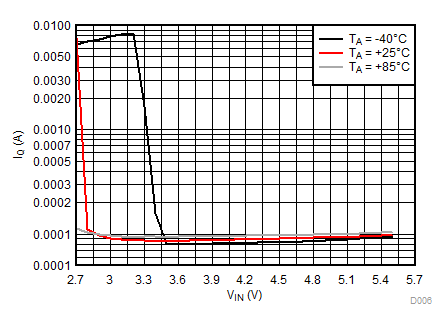 Figure 8. PFM Quiescent Current
Figure 8. PFM Quiescent Current
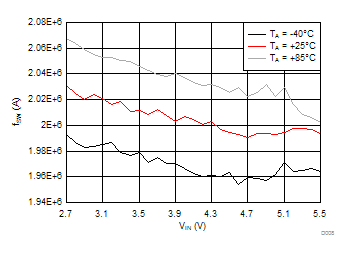 Figure 10. Switching Frequency
Figure 10. Switching Frequency
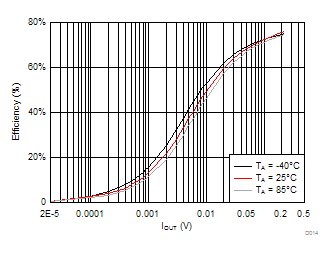 Figure 12. Efficiency vs Load Current
Figure 12. Efficiency vs Load Current
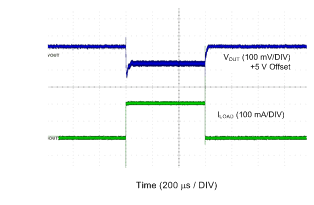
| VIN = 3.6 V |
ILOAD = 1 mA to 100 mA |
PFM = '1' |
Figure 14. PFM Load Step
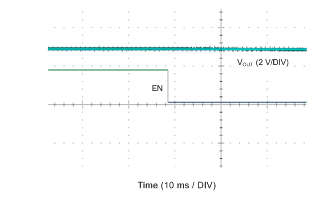 Figure 16. Output Discharge Disabled
Figure 16. Output Discharge Disabled
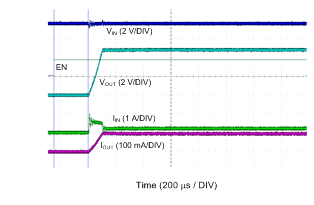
| VIN = 3.6 V |
ILOAD = 100 mA |
|
Figure 18. Start-Up into a Load

















